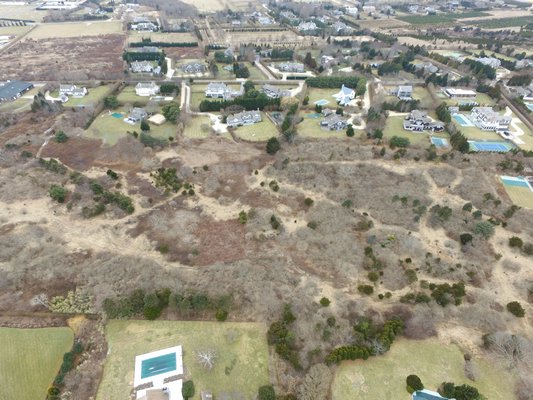
Agricultural reserves are a staple in the East End environment. A protection on farm land, these reserves are designed to save swaths of land from development, serving as a mechanism that keeps farming an integral part of life in the region.
But not all agricultural reserves are as restrictive as they seem.
Pamela Harwood, a longtime Bridgehampton resident and the chairwoman of the hamlet’s citizens advisory committee, recently pointed to a pair of adjoined properties roughly in the center of the hamlet—known as the Butter Lane Estates—that are targeted by some development as an example of this problem.
“Over the last several decades one of the most significant changes to Bridgehampton hamlet has been the loss of agricultural land blessed with rich ‘Bridgehampton loam’ to oversize housing and commercial development,” Ms. Harwood explained in an email this week.
She said the Butter Lane Estates proposal, targeting more than 26 acres of land off Butter Lane, is a clear violation of agricultural reserve covenants. During the January 29 CAC meeting, Ms. Harwood held up copies of planning board site plans that show the developer, Argo Corporation of New York City, is seeking to build a 7,220-square-foot residence with a garage on the pair of parcels. The plans also noted that the applicant is seeking other amenities, including a swimming pool and a tennis court, on the property.
Planning board Chairman Dennis Finnerty explained in a recent interview that while the property is an agricultural reserve, the underlying zoning—CR-80, or country residential with 2-acre zoning—allows for a house to be built.
Butter Lane Estates was one of the first agricultural reserves to be put in place in the town in the 1980s, Mr. Finnerty said. He explained that at the time the underlying zoning was intentionally left on the parcel: “If a farmer is going to farm the land they are going to need a place to live.”
If the underlying zoning was overwritten completely by the agricultural reserve, a developer couldn’t build a place for a potential farmer to live on the property.
Mark Moskowitz, the president of Argo Corporation, is requesting a special exemption permit from the planning board to build a 7,220-square-foot house with an attached patio and porch, a 1,120-square-foot garage, a 615-square-foot pavilion, a tennis court, a gravel driveway, and a 20-foot-by-50-foot swimming pool, according to the application.
While the language surrounding each agricultural reserve in the town can vary, Mr. Finnerty said that the zoning overlay still usually allows for small structures such as horse barns or sheds for farming equipment.
Mr. Finnerty said his department is working with the town attorney’s office to determine if the special exemption should be granted for Mr. Moskowitz’s proposal.
“We’re in the process of researching that,” Mr. Finnerty noted.
Generally speaking, Mr. Finnerty said agricultural reserves can be difficult to police because they are privately owned. The reserves allow the town’s planning and building departments to refuse permits to build on the land, but the town has a much harder time taking action on seemingly growing phenomenon: “sod farms,” or grass from backyards, being extended into agricultural reserves.
John v.H. Halsey, the founder of the Peconic Land Trust, which has more than 100 protected easements in Southampton Town, agreed that protecting agriculture reserves from the so called “sod farms” can be arduous.
“I think it’s going to be an ongoing challenge for all entities that hold development rights,” Mr. Halsey said. “If you’re not on top of it someone can slide something on it. Or farm land can become an extension of someone’s yard.”
Though Mr. Halsey noted “that it’s easier said than done,” he stressed that more mechanisms need to be in place to keep lawns from trickling over property borders and into agricultural reserves throughout town. The purpose of agriculture reserves in the first place, he said, was to set aside land so all of the region’s farmland doesn’t ultimately get converted to development.
“It’s essential to have land available for new farmers,” Mr. Halsey said. “That was the public purpose for setting that aside in the first place.”
When conservation easements are “gifted” to the Peconic Land Trust, Mr. Halsey said his nonprofit does a “baseline documentation” of the property that details the specs of the parcel and notes where the property lines end. Officials then follow up on the property annually to make sure all of the restrictions are met.
If lawns creep over the property line, the situation can usually be resolved by just notifying the offender. Otherwise, litigation would ensue. “Fortunately we haven’t had to do that very often,” Mr. Halsey said.
He added that while he is not familiar with the Butter Lane Estates reserve, it’s not unusual for space on an agricultural reserve to be set aside for a residence for the farmer to live in.
“Sometimes there’s a place open where you can build something,” he explained.
When Ms. Harwood held up the site plans for the Butter Lane Estates proposal during last month’s Bridgehampton CAC meeting, some other members also raised concerns about the potential new development in their community.
“This is so outrageous,” Jenice Delano observed.
Peter Wilson added that he worries that if the planning board allows the swimming pool and tennis court to be built here that it will send the message to developers that they could get approvals for similar constructions within agricultural reserves.
“The issue is the precedent that it sets,” Mr. Wilson said.